
CSS Arkansas was the lead ship of her class of two casemate ironclads built for the Confederate States Navy during the American Civil War. Completed in 1862, she saw combat in the Western Theater when she steamed through a United States Navy fleet at Vicksburg in July. Arkansas was set on fire and destroyed by her crew after her engines broke down several weeks later. Her remains lie under a levee above Baton Rouge, Louisiana at 30°29′14″N91°12′5″W.
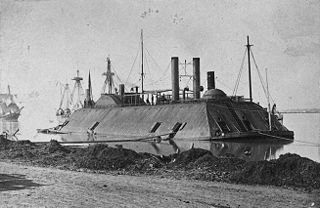
USS Essex was a 1000-ton ironclad river gunboat of the United States Army and later United States Navy during the American Civil War. It was named for Essex County, Massachusetts. USS Essex was originally constructed in 1856 at New Albany, Indiana as a steam-powered ferry named New Era.

The First Battle of Memphis was a naval battle fought on the Mississippi River immediately north of the city of Memphis, Tennessee on June 6, 1862, during the American Civil War. The engagement was witnessed by many of the citizens of Memphis. It resulted in a crushing defeat for the Confederate forces, and marked the virtual eradication of a Confederate naval presence on the river. Despite the lopsided outcome, the Union Army failed to grasp its strategic significance. Its primary historical importance is that it was the last time civilians with no prior military experience were permitted to command ships in combat. As such, it is a milestone in the development of professionalism in the United States Navy.
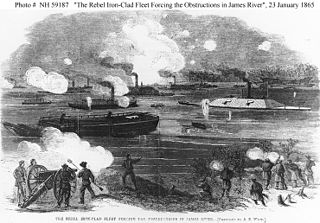
CSS Virginia II was a Confederate Navy steam-powered ironclad ram laid down in 1862 at the William Graves' shipyard in Richmond, Virginia. Acting Constructor William A. Graves, CSN, was the superintendent in charge of her construction. In order to conserve scarce iron plating, he ordered the ship's armored casemate shortened from the specifications given in John L. Porter's original building plans; in addition, the ship's iron-plating, while six inches thick on the casemate's forward face, was reduced to five inches on her port, starboard, and aft faces. Due to the shortening of her casemate, the number of her cannon were reduced to a single 11" smoothbore, a single 8" rifle, and two 6.4" rifles.

The Battle of Mobile Bay of August 5, 1864, was a naval and land engagement of the American Civil War in which a Union fleet commanded by Rear Admiral David G. Farragut, assisted by a contingent of soldiers, attacked a smaller Confederate fleet led by Admiral Franklin Buchanan and three forts that guarded the entrance to Mobile Bay: Morgan, Gaines and Powell. Farragut's order of "Damn the torpedoes! Four bells. Captain Drayton, go ahead! Jouett, full speed!" became famous in paraphrase, as "Damn the torpedoes, full speed ahead!"

CSS Tennessee was a casemate ironclad ram built for the Confederate Navy during the American Civil War. She served as the flagship of Admiral Franklin Buchanan, commander of the Mobile Squadron, after her commissioning. She was captured in 1864 by the Union Navy during the Battle of Mobile Bay and then participated in the Union's subsequent Siege of Fort Morgan. Tennessee was decommissioned after the war and sold in 1867 for scrap.

CSS Manassas, formerly the steam icebreaker Enoch Train, was built in 1855 by James O. Curtis as a twin-screw towboat at Medford, Massachusetts. A New Orleans commission merchant, Captain John A. Stevenson, acquired her for use as a privateer after she was captured by another privateer CSS Ivy. Her fitting out as Manassas was completed at Algiers, Louisiana; her conversion to a ram of a radically modern design made her the first ironclad ship built for the Confederacy.

USS Hartford, a sloop-of-war steamer, was the first ship of the United States Navy named for Hartford, the capital of Connecticut. Hartford served in several prominent campaigns in the American Civil War as the flagship of David G. Farragut, most notably the Battle of Mobile Bay in 1864. She survived until 1956, when she sank awaiting restoration at Norfolk, Virginia.
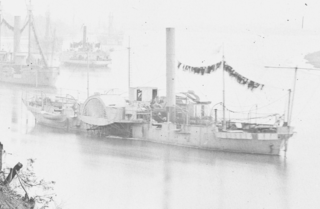
The first USS Miami was a side-wheel steamer, double-ender gunboat in the United States Navy during the American Civil War.

The USS Queen of the West was a sidewheel steamer ram ship and the flagship of the United States Ram Fleet and the Mississippi Marine Brigade. It was built at Cincinnati, Ohio in 1854. It served as a commercial steamer until purchased by Colonel Charles Ellet Jr. in 1862 and converted for use as a ram ship. The ship operated in conjunction with the Mississippi River Squadron during the Union brown-water navy battle against the Confederate River Defense Fleet for control of the Mississippi River and its tributaries during the American Civil War.

USS Varuna was a screw steamer acquired by the Union Navy during the American Civil War. Under construction in 1861, she was purchased incomplete on 31 December. After being commissioned in February 1862, she traveled to join the West Gulf Blockading Squadron. Varuna was present when Flag Officer David Glasgow Farragut led an attack against Confederate positions at Fort Jackson and Fort St. Philip on 24 April. During the action, Varuna ran ahead of the other Union ships, and was engaged in a chase with the Louisiana gunboat Governor Moore. After closing in on the Union ship, Governor Moore rammed Varuna twice, with the gunboat CSS Stonewall Jackson adding a third blow. Varuna sank within 15 minutes, but Farragut was able to capture the city of New Orleans, Louisiana.
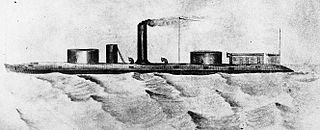
USS Winnebago was a double-turret Milwaukee-class river monitor, named for the Winnebago tribe of Siouan Indians, built for the Union Navy during the American Civil War. The ship participated in the Battle of Mobile Bay in 1864, during which she was lightly damaged, and the bombardments of Forts Gaines and Morgan as Union troops besieged the fortifications defending the bay. In early 1865, Winnebago again supported Union forces during the Mobile Campaign as they attacked Confederate fortifications defending the city of Mobile, Alabama. She was placed in reserve after the end of the war and sold in 1874.

The Battle of forts Jackson and St. Philip was the decisive battle for possession of New Orleans in the American Civil War. The two Confederate forts on the Mississippi River south of the city were attacked by a Union Navy fleet. As long as the forts could keep the Federal forces from moving on the city, it was safe, but if they fell or were bypassed, there were no fall-back positions to impede the Union advance.

USS Mound City was a City-class ironclad gunboat built for service on the Mississippi River and its tributaries in the American Civil War. Originally commissioned as part of the Union Army's Western Gunboat Flotilla, she remained in that service until October 1862. Then the flotilla was transferred to the Navy and she became part of the Mississippi River Squadron, where she remained until the end of the war.

New Orleans, Louisiana, was the largest city in the South, providing military supplies and thousands of troops for the Confederate States Army. Its location near the mouth of the Mississippi made it a prime target for the Union, both for controlling the huge waterway and crippling the Confederacy's vital cotton exports.
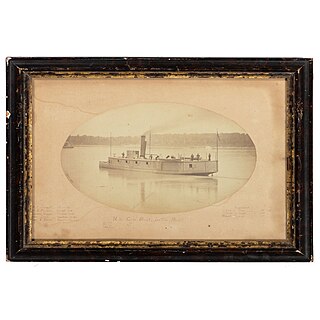
Little Rebel was a cotton-clad ram that had been converted from a Mississippi River steamer to serve as the flagship of the Confederate River Defense Fleet in the American Civil War. Sent from New Orleans to defend against the Federal descent of the Mississippi, she was among the force that engaged vessels of the Union Army's Western Gunboat Flotilla at the Battle of Plum Point Bend on May 10, 1862. On June 6, she again was involved in an action with the Federal gunboats, this time at the Battle of Memphis. In the battle, a shot from a Federal gun pierced her boiler, disabling her, and she was then pushed aground by the Federal ram USS Monarch and captured.

The River Defense Fleet was a set of fourteen vessels in Confederate service, intended to assist in the defense of New Orleans in the early days of the American Civil War. All were merchant ships or towboats that were seized by order of the War Department in Richmond and converted into warships by arming each with one or two guns, protecting their engines by an interior bulkhead, and strengthening their bows so they could be used as rams. Although they were nominally a part of the Confederate States Army, all of their officers and most of their crews were civilians. A portion of the fleet was retained in the south part of the Mississippi River and a portion was sent north to defend against Union movement from the north.
CSS Mississippi was a projected ironclad warship of the Confederate States Navy, intended to be used on the Mississippi River in the vicinity of New Orleans during the American Civil War. Her design was unusual, as she was built according to house-building techniques. Whether this would have proved to be feasible cannot be known, as she was not complete when New Orleans fell to the Union Fleet under Flag Officer David G. Farragut on 25 April 1862. Rather than let her fall into enemy hands, Captain Arthur Sinclair, CSN, ordered her to be hastily launched and burned. Despite the delays in construction that left her unfinished and untried, her mere existence, together with that of CSS Louisiana, raised thwarted hopes in the defenders of New Orleans, and unfounded fears in Union circles, that affected the strategy of both sides in the campaign on the lower Mississippi. Mississippi is significant to the Civil War therefore not so much as a warship as in the way her reputation influenced events, and as an example of the difficulties the South had in the contest with the industrial North.


CSS Ivy was a sidewheel steamer and privateer purchased by Commodore Lawrence Rousseau for service with the Confederate States Navy, and chosen by Commodore George Hollins for his Mosquito Fleet. The Mosquito Fleet was a group of riverboats converted to gunboats, and used to defend the Mississippi River in the area of New Orleans during the American Civil War.





















